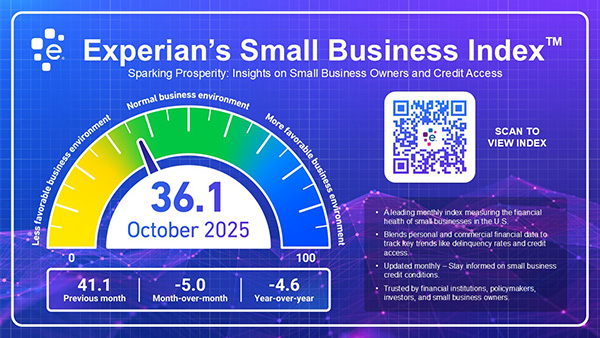Featured

Experian Commercial Pulse Report Explores Implications of Rising Premiums As the year draws to a close, one issue looms large for millions of small business owners: the rising cost of healthcare. According to the latest Experian Commercial Pulse Report, small business survival may soon hinge on a single factor — whether enhanced Affordable Care Act (ACA) subsidies are extended into 2026. Watch the Commercial Pulse Update The Clock Is Ticking on ACA Subsidies The American Rescue Plan and Inflation Reduction Act temporarily expanded ACA subsidies, helping make coverage more affordable for millions. But those enhancements are set to expire at the end of 2025 — a policy shift that could unleash a wave of economic strain. The Kaiser Family Foundation estimates that if these subsidies lapse, individuals who purchase insurance through the ACA marketplace could see a 75% increase in premiums. Why does this matter so much for small businesses? Because half of all ACA marketplace enrollees are small business owners, entrepreneurs, or their employees. Coverage Is Shrinking, and Costs Keep Climbing Smaller businesses have historically been less likely to offer health insurance benefits than their larger counterparts. In 2025, only 64% of businesses with 25 to 49 employees offer health benefits — the lowest level ever recorded. And while large employers are still required by the ACA to offer coverage to full-time workers, they too are feeling the pressure. Since 2010, employers have gradually reduced the share of healthcare premiums they cover, even as deductibles have risen by 164% for single coverage plans. The result? Business owners are being squeezed from both sides — by rising insurance costs and a more financially stressed workforce. The Ripple Effects Could Be Widespread If enhanced subsidies aren’t renewed, many small businesses may have no choice but to: Shut down operations Cut staff Shift jobs into larger organizations that can offer coverage That would be a blow not only to small business dynamism but also to broader economic sectors. Reduced consumer spending could hit industries like retail, real estate, and manufacturing, while healthcare providers face payment cuts and job losses due to shrinking coverage pools. What’s Next? With Congress set to vote on subsidy extensions before the end of the year, the stakes couldn’t be higher. The outcome will likely define affordability, access, and entrepreneurship for years to come. For small business owners, now is the time to assess your coverage plans, understand your employee needs, and prepare for potential cost increases. For policymakers and industry leaders, it’s a critical moment to ensure healthcare reforms continue to support the backbone of the U.S. economy — small businesses. Experian continues to provide actionable data to help businesses, lenders, and policymakers navigate uncertainty. To access the full Commercial Pulse Report and explore more insights on small business credit and sector-specific performance: ✔ Visit our Commercial Insights Hub for in-depth reports and expert analysis. ✔ Subscribe to our YouTube channel for regular updates on small business trends. ✔ Connect with your Experian account team to explore how data-driven insights can help your business grow. Download the Commercial Pulse Report Visit Commercial Insights Hub Related Posts

The Experian Small Business Index™ declined in October, dropping by 5.0 points month-over-month. Oct 2025 Index Value (Oct): 36.1 Previous Month: 41.1 MoM: -5.0 YoY: -4.6 (Oct 2024 = 40.7) The Experian Small Business Index™ decreased in October by 5 points to 36.1. This drop is attributable to decreased origination activity for small businesses and small business owners, along with an increase in delinquencies for small business owners’ consumer trades. Small business trade delinquency rates have remained stable. The NFIB reported a decrease in small business optimism to 98.2 in October from 98.8 in September, and the University of Michigan reported a drop in consumer sentiment to 51.1 in November from 53.6. Due to the extended government shutdown, several of the economic indicators were not reported for October, but there were signs of positive factors in the macroeconomic environment. US employers reported hiring 283K in October, up from 117K in September, and existing home sales were up 1.2% in October to 4.1M. Explore Experian Small Business Index Related Posts

The independent workforce is booming, but traditional financial services have struggled to keep pace. On a recent episode of Experian Business Chat, Michael Zevallos, co-founder of Giggle Finance, shared how his FinTech is bridging this critical gap for gig workers and micro-small businesses. Watch Our Interview The Problem: A Broken System for Independent Workers With over 10 years of experience in online lending and FinTech, Michael witnessed firsthand how the financial system failed anyone outside traditional W2 employment or large commercial businesses. During his time at OnDeck, starting in 2011, he witnessed numerous independent contractors and micro-small businesses being completely shut out of credit markets. "It wasn't just about meeting underwriting guidelines," Michael explains. "Smaller deals just didn't generate enough profitability. There were too many hands in the cookie jar—underwriters, salespeople, loan brokers, loan closers—all trying to interact with these deals." The traditional system relies on predictable W2 paychecks and consistent business histories spanning five-plus years. But gig workers operate differently. An Uber driver might work 10 hours one week, 20 the next, and zero the week after. This variability, while reflecting the freedom of independent work, made them invisible to traditional lenders. A Market Opportunity Hiding in Plain Sight What started as a niche problem became impossible to ignore. In 2020, the independent workforce became the fastest-growing segment of the economy. Suddenly, tens of millions of Uber drivers, barbers, content creators, online sellers, and freelancers needed financial services that simply didn't exist for them. That's when Michael and his co-founders launched Giggle Finance. Flipping the Script on Risk Assessment Traditional credit markets look backward, reviewing historical output, past credit scores, and established track records. But as Michael points out, "It captures your past, but it doesn't capture your present or more importantly, your future." Giggle Finance partnered with Experian to develop a more nuanced approach to risk: Experian's Clear Credit Risk and Clear Inquiry go beyond traditional credit files to identify different patterns of behavior and risk signals that matter for independent workers. This allows them to go beyond a traditional credit report, predict risk more accurately, and approve the right customers. NeuralID Technology analyzes how customers interact with the application itself, detecting fraud while building confidence in legitimate applicants. The Experian SMB Marketplace connects Giggle with customers who genuinely care about and value their credit, allowing them to approve more applications with greater confidence. The result? Giggle can assess risk and approve applications in under 10 minutes, requiring just 90 days of cash flow activity to get started. "Consider a freelance marketer who could previously handle two or three clients. With AI tools for content creation and analytics, they can now manage five or six times that workload."Michael Zevallos, Co-Founder The AI Revolution in Independent Work The conversation took an interesting turn when discussing how AI is reshaping the gig economy. While most people think about AI's impact on large enterprises, Michael sees it transforming independent contractors in profound ways. "Gig workers aren't just drivers or delivery couriers anymore," he notes. "They're becoming creators, consultants, designers—more tech-savvy and capable than ever before." Consider a freelance marketer who could previously handle two or three clients. With AI tools for content creation and analytics, they can now manage five or six times that workload. Many solopreneurs are evolving into full-fledged agencies, keeping headcount low while scaling to dozens of customers. From Emergency Funding to Growth Capital This AI-enabled transformation has fundamentally shifted why customers seek financing. Historically, small business owners came to Giggle because of emergencies—they needed to make payroll or cover an unexpected expense. Now, increasingly, they're seeking growth capital. The Uber driver who becomes a limousine company owner. The logo designer who can now produce dozens of designs using AI tools. These entrepreneurs need funding to hire people, invest in equipment, and market their expanding businesses. "That structural shift is very exciting for both the customers and for us at Giggle," Michael says. Building Long-Term Relationships Giggle isn't just there for a one-time transaction. Some customers have been funded over 20 times across four years, with Giggle supporting them through various business evolutions. Uber drivers have become truckers. Others have launched limousine companies. The relationship grows as the business grows. Looking ahead, Giggle plans to expand its offerings, including a potential line of credit product for more mature businesses. The goal is to remain flexible and responsive to changing business needs at every stage. The Path Forward: Collaboration Michael sees tremendous opportunity for banks and FinTechs to work together serving the gig economy. Banks bring trust, established brands, and balance sheets. FinTechs like Giggle bring product innovation, technology, and user experience. "If you put those strengths together, you can build a financial system that truly serves gig workers, independent contractors, and micro-small businesses," he explains. Giggle's technology can underwrite customers in seconds using real-time income data and AI, while bank partnerships could provide credit at scale. A Market That's Only Getting Bigger When Giggle launched in 2020, there were approximately 30 million independent workers in the United States. Today, that number has more than doubled to 70 million. By 2030, Experian and Giggle believe the independent contractor workforce will surpass the traditional W2 economy. "Everybody's a small business. Whether it's a college student with an Etsy store, a professional with a side consulting practice, or a full-time independent contractor, the entrepreneurial spirit is becoming the norm rather than the exception."Ekaterina Gaidouk, VP of Marketing Getting Started For entrepreneurs and small business owners interested in learning more, Giggle Finance operates entirely online at www.gigglefinance.com. The application process takes less than 10 minutes, and approved customers can have funds in their bank account the same day—no human intervention required. In an age where the nature of work is rapidly evolving, Giggle Finance represents a new approach to financial services: one that recognizes independent workers not as risky outliers, but as the future of the American economy. Related Posts

Discover how Experian’s Fraud Investigation Report unifies fraud and credit scoring to help risk managers detect threats early, streamline onboarding, and make smarter lending decisions.

This handy guide explains the practice of Credit Portfolio Management, managing, and monitoring all aspects of your company's credit portfolio.
